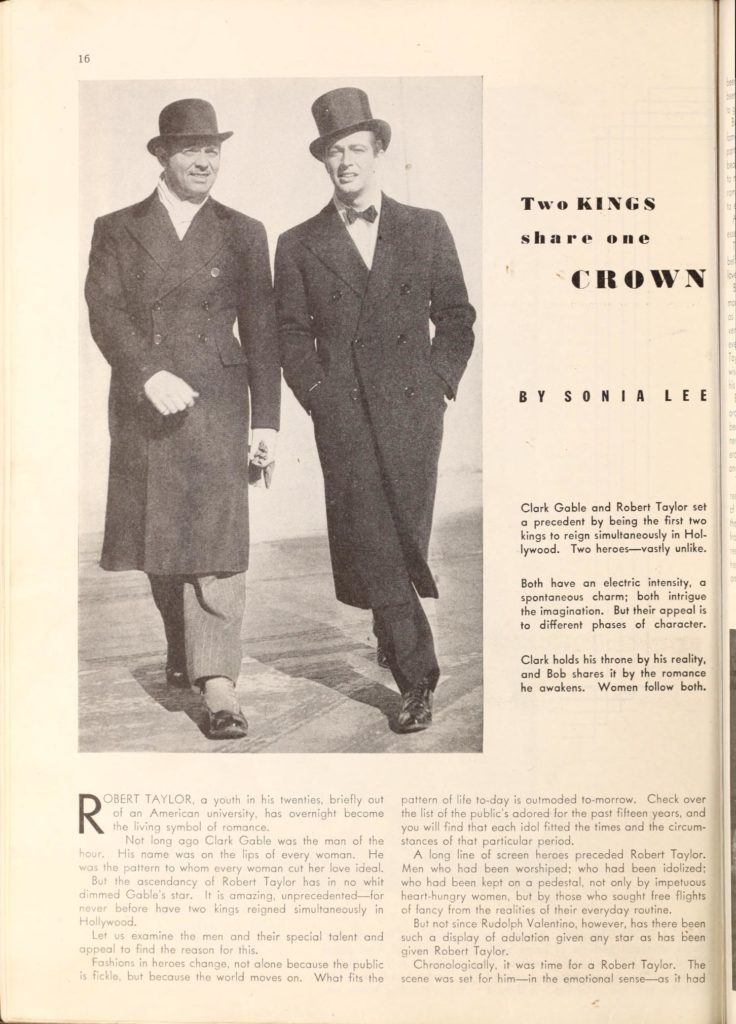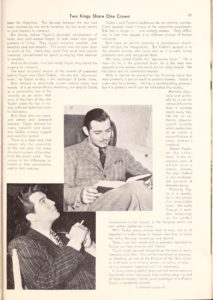1937: Two Kings Share One Crown
Two Kings Share One Crown
By Sonia Lee
Picture Play magazine, November 1937
Clark Gable and Robert Taylor set a precedent by being the first two kings to reign simultaneously in Hollywood. Two heroes—vastly unalike.
Both have an electric intensity, a spontaneous charm; both intrigue the imagination. But their appeal is to different phases of character.
Clark holds his throne by his reality, and Bob shares it by the romance he awakens. Women follow both.
Robert Taylor, a youth in his twenties, briefly out of an American university, has overnight become the living symbol of romance.
Not long ago Clark Gable was the man of the hour. His name was on the lips of every woman. He was the pattern to whom every woman cut her love ideal.
But the ascendancy of Robert Taylor has in no whit dimmed Gable’s star. It is amazing, unprecedented—for never before have two kings reigned simultaneously in Hollywood.
Let us examine the men and their special talent and appeal to find reason for this.
Fashions in heroes change, not alone because the public is fickle, but because the world moves on. What fits the pattern of life today is outmoded tomorrow. Check over the list of the public’s adored for the past fifteen years, and you will find that each idol fitted the times and the circumstances of that particular period.
A long line of screen heroes preceded Robert Taylor. Men who had been worshiped; who had been idolized; who had been kept on a pedestal, not only by impetuous heart-hungry women, but by those who sought free flights of fancy from the realities of their everyday routine.
But not since Rudolph Valentino, however, has there been such a display of adulation given any star as has been given Robert Taylor.
Chronologically, it was time for a Robert Taylor. The scene was set for him—in the emotional sense—as it had been for Valentino. The decade between the two had been marked by too much hardship, by too much reality to give impetus to romance.
But shortly before Taylor’s skyrocket achievement of fame, men and women began to seek newer and gayer patterns of living. They sought romance, emotion, new beauties and new dreams. The screen was the open door to much of this. Here they could find quick and concise romance, concentrated for quick journeying from emotion to emotion.
And on the screen, in a lad called Taylor, they found the essence of romance.
The most successful wearer of the mantle of greatness before Taylor was Clark Gable. He was the “depression lover,” as Taylor today is the harbinger of better times.
Both defined to exactitude current mental states and moods. It is an extraordinary testimony, not only to Gable as a personality, but to his veracity as an actor, that even in the light of the new Taylor craze he has nowise suffered defections from his followers.
Both these stars are standard setters and standard bearers. Taylor defined the newly romantic and easier era; Gable, a more rugged and exacting period.
There is a deep and vital reason why the popularity of the one does not erase the consciousness of the other from public mind. That reason is the difference inherent in their personalities and in their natures.
Gable’s and Taylor’s audiences do not entirely overlap. Clark appeals more strongly to the masculine population; Bob had a larger audience among women. They differ, too, in that their appeal is to different phases of human character.
Both have an electric intensity, a spontaneous charm; both intrigue the imagination. But Gable’s appeal is to the modern woman who faces fact as it is—who knows problems exist and recognizes them.
We have called Gable the “depression lover.” He is that—for he is the practical lover; he is the man who appeals to the woman who works for her daily bread. He has force and he commands respect/
After a fashion he personifies the Victorian ideal that man primarily is put on earth to protect women. Gable is rude—but he is tender. He had a swashbuckling glamour, but it is glamour which can be translated into reality.
Mentally, physically and spiritually he is not far removed from the men a woman meets every day. He has an authentic down-to-earth quality which makes him, to an extent, a personification of every woman’s husband.
Robert Taylor, on the other hand, is the impetuous lover of whom every woman dreams, the man clothed in the insubstantial garments of feminine fancy.
Primarily Taylor is that symbol: he is the unreal, the intangible lover. He walks through a woman’s imaginings as the perfect complement to her moods, to her longings which she can neither define nor voice.
With Taylor, every woman feels at ease, not at all impelled to make rhyme or reason—but free to follow her will-o’-wisp dreamings and desires.
There is no fear with a woman’s reactions to Taylor, as there must be with Gable.
Taylor might be well imagined as the hero of every romance since Eve. He can be conceived as Leander, as Abelard, as one of the Knights of the Holy Grail. In brief tunic or shining armor—in ruffles or wigs—all the romantic trappings suit him admirably.
In every century and in every period where romance flourished; where impetuous love-making rang the bell of hope in women’s minds, some prototype of a Robert Taylor undoubtedly existed.
Gable and Taylor. One the equivalent of fact, of modernity, with only a seasoning of emotion. The other, Taylor, with his youth, with his impetuous quality, never quite taking on the semblance of reality.
As they differ in personality and sentiment, as they differ in the interpretation of the various roles in which they are cast, so these two men, both idols, differ certainly in the things they represent and interpret.
Perhaps because we all are products of our environment, it is understandable that Gable be one type of lover and Taylor the other.
Clark has known vicissitude and hardship and hunger. He has been tempered in the fire of deprivation and despair. From the time when, as a boy, he worked in the oil fields of Oklahoma, to the time when he was a lumberjack in Oregon, he has worked with his hands.
He had few illusions left by the time he came to Hollywood. He was a sophisticate in the sense that his views were broad and tolerant. He saw foibles and idiosyncrasies and shortcomings but censured none for their possession.
But as Gable is the product of the modern world of give-and-take, of sharp competition, of the twentieth-century philosophy that to the victor belong the spoils—so in contrast Taylor is the product of a cloistered world.
Son of a mid-Western physician, he early had every advantage that a boy could have; the right toys, the right food, the right exercise, the right companionship, the right education, the right training—all these were his without question.
As he grew older, nothing was lacking in his life. He met no sharp struggles to bewilder him or to confuse the even tenor of his days. After high school, there was college. All in all, a leisurely, normal, right life for a boy of his years.
He has no corroding memories of physical lacks. He has never gone hungry; he has never been cold; he has never been without suitable clothing. He made the jump from college directly into a studio. Whatever struggles he may have had in his rise to fame, they were not devastating. Normal disappointments, impatience, discouragement—yes. But none strong enough to scar him.
He has no deep-seated memories of hurts as Gable has.
When he appeared in “Magnificent Obsession” that untouched quality about Taylor was evident. Here was a boy with illusions intact. And that breathless sense of romance, which in the final analysis is the thing which has made Taylor the favorite he is today.
As Taylor grows older, as he is matured in his talents and in his personal life, a quality of fantasy which lingers around him will probably be dispelled and then he will be a greater idol. For he will give to women the two things they want—reality plus romance.
In Gable that romance only flashes out. In Taylor it is a constant factor.
In effect, Gable and Taylor today are sharing the affections and romantic notions of the world as a whole. They have both set standards—and women follow both.
That is as it should be, for women are complex and their needs are multiple and changing.
So Gable holds his throne by his reality, and Taylor shares it by the romance he awakens.
Two heroes—Gable and Taylor—vastly unalike. Both great.

